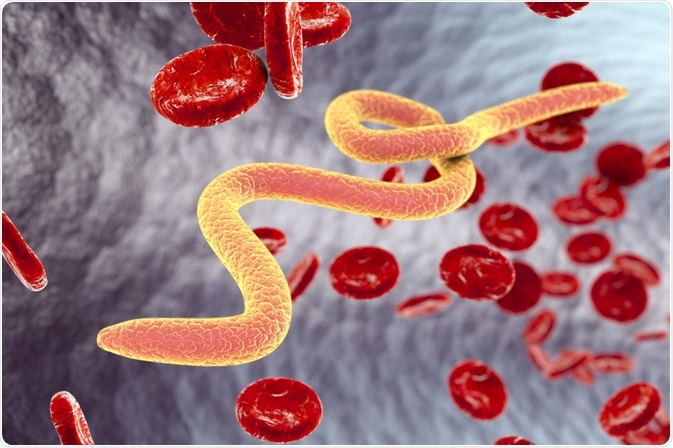Angiostrongyliasis, or rat lungworm disease, is a type of disease that affects the spinal cord and the brain in human beings.

Image Credit: Kateryna Kon / Shutterstock.com
Introduction
Angiostrongylus cantonensis, which is a parasitic nematode found in rodents, is the root cause of this disease. Snails and slugs, as well as other animals, serve as mediators of this parasite and when humans consume such animals, or food and/or water that has been contaminated by the larvae of the rat lungworm, they are also vulnerable to getting affected by the disease.
These parasites were first identified in China in 1935. Since the discovery of A. catanonensis in 1944 as the cause of Eosinophilic Meningitis in Taiwan, a considerable amount of research has been done to study this specific parasite.
With the first study on A. catanonensis published in 1955, researchers Mackerass and Sanders determined the life cycle of the parasite in rats. Moreover, both snails and slugs were identified as intermediate hosts. This study also determined the transmission path of the rat lungworm to go through the blood, brain, and lungs of rats.
Research based in Hawaii
The Hawaii islands, which are a part of the United States of America, are considered to be the most affected area by rat lungworm disease.
In 1961, three researchers including Rosen, Laigret, and Bories conducted a study to determine whether fish carried the parasite that caused eosinophilic meningitis in humans. Since a large number of people living in the Haiwaiin islands during this time were infected with the parasite, these individuals were sampled and often found to consume a diet that was high in raw fish. In fact, patients who showed symptoms of meningitis had a history of having raw snails or prawns within two weeks before presenting with the symptoms. Thus, when this study is combined with the epidemiology and autopsy of the patients’ brains, it proves that A. cantonensis is confirmed that snails, rather than fish, were the primary transmission hosts of this parasite.
In 1965, Joseph E. Alicata conducted a study titled “Biology and Distribution of the Rat Lungworm, Angiostrongylus cantonensis, and its Relationship to Eosinophilic Meningoencephalitis and other Neurological Disorders of Man and Animals.” The study described the role of the nematode in the migration, development, and production of eosinophilic meningoencephalitis in both humans and other host animals.
In June 2013, a study titled “A Severe Case of Rat Lungworm Disease in Hawaii” was published by Kathleen Howe. This case study described the eosinophilic meningitis experined by a 23-year-old man from the Hawaii islands, and how he recovered from the initial comatose stage until ultimately returning to normal 4 years later.
In July 2015, further research by the University of Hawaii revealed that the Puna district on the Island of Hawaii is the epicenter of rat lungworm disease in the U.S. Susan Jarvi and her research team at the university studied the possibility of detecting parasitic DNA in rat blood as a potential early diagnostic test of the disease in humans.
Understanding Rat Lungworm Disease
Research based in Australia
In Australia, the history of rat lungworm was studied by two researchers, M.J. Mackerras and D.F. Sandars in 1955. Their research explains the life cycle and development of the parasite from rats to humans. Stage-by-stage, the research clearly marks the entire journey of the parasite, with the exact number of days needed in each stage.
Research based in Thailand
A study of eosinophilic meningitis was conducted over a period of 3 years in Thailand that ended in March 1968. A total of 640 patients with eosinophilic pleocytosis were considered as samples and 484 cases of eosinophilic meningitis were found among them. The symptoms at various stages of the disease were studied and it was determined that neither steroids nor antibiotics had much of an impact on treating the illness.
Research based in China
Between 2006 adn 2007, China conducted the first national survey on A. cantonensis, which involved 160 patients. The research on this group of individuals, which was eventually publishedi in February of 2009, found that two snails were responsible for carrying the rat lungworm—A. fulica and P. canaliculata. These snails were responsible for the outbreak of angiostrongyliasis in the mainland of China, which was previously a rare disease.
Research based in Brazil
Since 2007, seven cases were reported in Brazil showing infection by A. cantonensis. By 2013, a study titled “Angiostrongylus cantonensis and Rat Lungworm Disease in Brazil” was published on the disease. This study detailed information on two infected specimens of Rattus norvegicus and Rattus rattus, as well as many species of mollusks, including the giant African land snail from various regions of Brazil.
The study proposes many suggestions for the control and monitoring of hosts, both intermediate and definitive. More specifically, the researchers emphasized the need for creating awareness to the public on disease transmission and prevention.
References
Further Reading